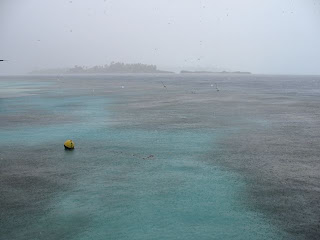This morning Eric announced that we would be going to the pass. Raimiti is closer to the southern pass, Tumakohua, which is smaller than the one at the north end of the atoll. The locals say that Tumakohua is the prettiest pass in the Tuamotus. As we arrived to the pass, the choppy swells looked ominous and foreboding. You couldn’t see past the steely blue surface, and my swimming apprehension leapt up higher once Eric said we had to jump in the water from the side of the boat (1.5 meters above the ocean). My friends know that I am a wimp when it comes to water. I don’t jump in any water, especially not in half-meter swells where everything looks scary! Instead of jumping, I slid down and held on to the edges of the boat before letting go. I got rebuked for doing this, as it is dangerous, and told I needed to jump next time.
Once I was in the water all my fears evaporated. I was looking at a wall of coral. The coral started about 30 centimeters below the surface and stayed level until the beach. Where we were swimming though, was over the steep slope of coral going down to the bottom of the pass. At the floor of the lagoon, the coral didn’t end, but it shifted to a more gradual slope. Since it wasn’t sunny, the corals color wasn’t eye smarting, but it was still very vibrant. There were blues, purples, reds, yellows and greens. The textures were mind-boggling. There were brain corals that had lovely gentle lumps, branch corals with spiky arms. Some looked like a popcorn conglomerate, while others looked like the upward brushstrokes of a painter. Some were massive, easily larger than me, while other were small and delicate, with a multitude of little branches.
And the fish were indescribable, you would have to have been there to be able to appreciate all the different shapes sizes and colors. There were parrotfish of several different varieties, meter long five cm tall yellow trumpet fish, and many others that I don’t know the name of. There were little blue green ones that hang out in huge schools. When I dove down to see them better, they sunk just a couple feet lower, but too low for me to go. Their color flickers with each flick of their tails, so it is hard to tell what color they really are. But one thing all the fish had in common, they were bright and colorful. At a quick glance the reef looked like a crazy painters canvas, with large splashes of color all over the place. Of course, sharks are fish too, and there were plenty of them. They have long graceful, sleek bodies that move effortlessly through the water. At first each one I saw was a cause for pointing and amazement, but there were so many of them that, while they were still appreciated, they no longer set my heart racing. Luckily, it was only after I got out that they started coming in shallower, to a little sheltered pool. The sight of four or five 6 feet long sharks in meter and a half water would have made me quite panicky.
At the end of our swim, right before we were going to get out, it started raining.  The water got all cloudy and I started shivering. But I saw a Napoleon. Napoleons are meter long (at the smallest) bright turquoise fish (wrasses). They are magnificent.
The water got all cloudy and I started shivering. But I saw a Napoleon. Napoleons are meter long (at the smallest) bright turquoise fish (wrasses). They are magnificent.
The Napoleon Wrasses, along with the Triton , are the only natural predators of the Crown of Thorns Starfish. The Crown of Thorns Starfish are naturally occurring enormous starfish that eat the coral reefs. In the past, their numbers have been held in check, but recently, with the over fishing of the Napoleon and gathering of Tritons shells for tourists, the starfish’s numbers re rising. The Crown of Thorns Starfish, combined with effects global warming (increased ocean temperature and higher UV) pose a serious problem for the coral reefs.